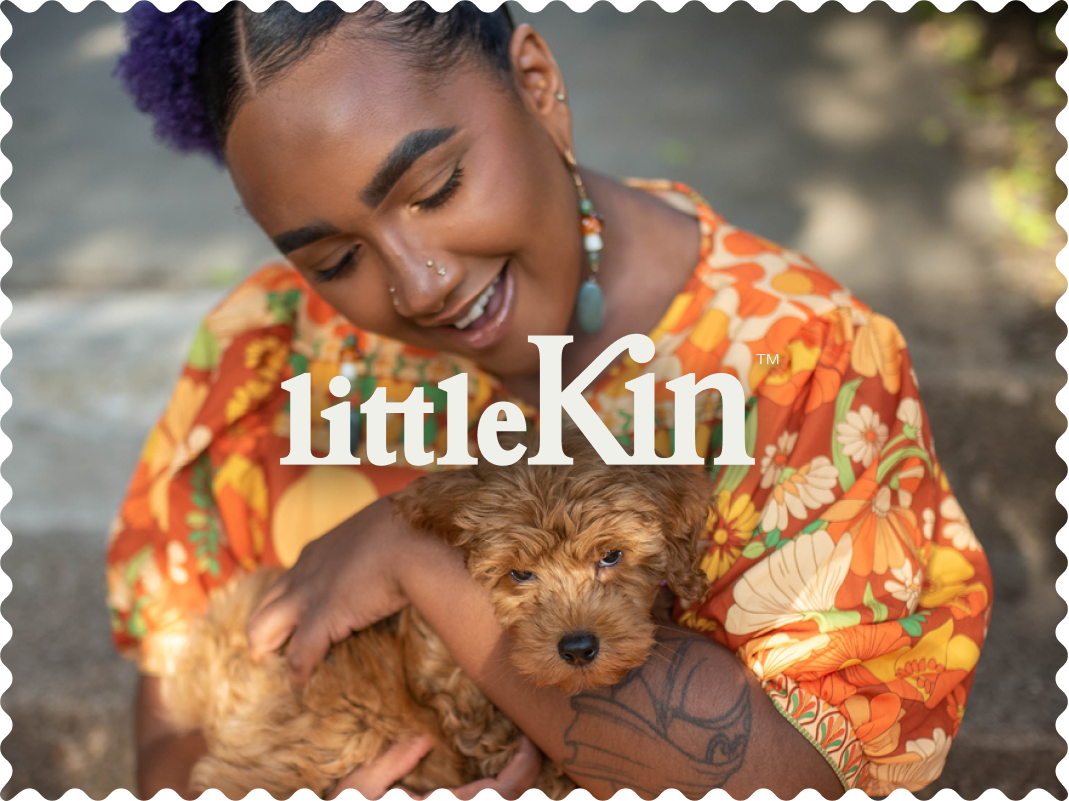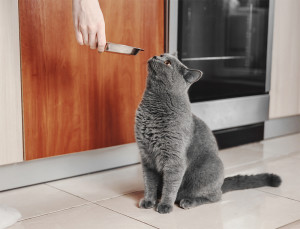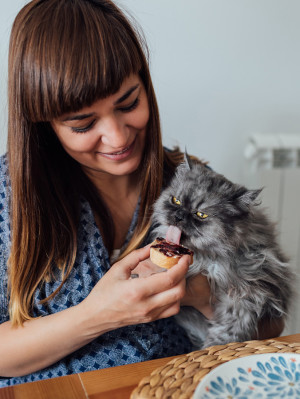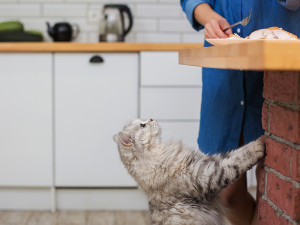How to Switch Cat Food: Managing a Picky Eater
It’s not easy, but you can do it.

Share Article
In This Article:
Benefits of Changing Cat Food How To Transition Cat To New Food Overcoming Challenges
Maybe your kitty is a bit on the chunky side. They could have a medical issue. Finances may have changed. These are just a few reasons you may need to change your cat’s food throughout their life. This can be tricky. They’ve eaten the same thing for months, or even years. Their digestive systems are used to that food. Switching to something new can sometimes throw a wrench in the works.
It’s even trickier if you have a picky eater. Some cats really like one food or protein source. Maybe they felt sick when eating other food in the past, leaving them nervous about new options. It could be a wet or dry food preference.
Don’t worry! We’ll talk you through switching your cat’s food in a way that’s much less likely to cause digestive issues. And we’ll give you some tips and tricks to nudge your picky eater in the right direction.

Benefits of changing cat food
While it’s great to continue your cat on their current diet if all is well, there may be important reasons you need to consider a change. Here are some of the potential benefits of a food change, depending on your situation and your cat’s health.
Weight
For cats who need to gain or lose weight, a special diet can help. It could be a higher-protein, lower-fat diet for a chunky cat. Switching from dry food to wet food is often recommended for weight loss as well.
Weight gain may require a different approach, with higher calorie diets or big flavors to pique interest in eating.
Age and life stage
Kittens transitioning into adulthood and adults moving into their senior years are two significant life changes that often come with a change in food. Kittens need more fat and calories as they’re growing and burning tons of energy. But eating that same food as an adult is likely to cause weight gain.
Seniors may need more fiber for digestive health and benefit from special nutrients as their bodies change.
Health
Many medical conditions benefit from a change in diet. Sometimes you need to add or remove certain minerals or vitamins. Special prescription diets can be helpful for cats with things like urinary crystals or sensitive stomachs. Cats can have food allergies or sensitivities. These kinds of recommendations should always come from your veterinarian.
Dental issues
Your vet may recommend special food to support your cat’s dental health and comfort. Some diets are formulated to reduce plague and provide other oral benefits. A cat with missing teeth or oral sensitivity may need to transition from dry to wet food.
Hydration
Cats naturally have a very low thirst drive. In the wild, they’d get much of their daily moisture from their prey. Cats primarily eating dry food are prone to things like dehydration and highly concentrated urine, which can lead to urinary issues.
Your vet may suggest adding wet food to your cat’s diet, or adding water to their wet or dry food, to provide more moisture, especially if they have a history of urinary issues.
How to transition your cat to new food
If your cat has a history of finicky eating or isn’t very food motivated, you’re probably concerned about this change. Do you buy 10 different kinds of food and try them all? Do you put out the new option, and they either eat or starve?
Different recipes and ingredients may cause stomach upset. It’s best to avoid a roulette wheel of trying and discounting many different foods if your cat is picky or has a sensitive belly. Starving is obviously not on the table (no pun intended). This transition shouldn’t cause stress for your cat.
Let’s look at a simple transition schedule that can help limit digestive upset.
Determine the right serving size
Use the guidelines on the food packaging as a general guide. But it’s best to consult with your veterinarian about serving size. Your vet will take multiple factors into account, like health issues, your cat’s activity level, their current weight, etc.
Cats must eat multiple times a day. They have very small stomachs and will start to get hungry after about five hours. If your cat is going more than eight hours without access to food, they’re hungry! Shoot for at least three meals per day.
Take the daily amount your vet recommends, split into the number of meals you’ll be feeding, to get your serving size for each meal.
Follow a 10-day transitional schedule
Make the change gradually, mixing the new food in with the old food.
First few days: 75 percent old food mixed with 25 percent new food.
Around day four: 50 percent old food with 50 percent new food.
Around day seven: 25 percent old food with 75 percent new food.
At around the 10-day mark, you can transition completely to the new food.
Depending on your cat’s digestive situation and how well they tolerate the new food, you may need to slow this down for a more gradual transition. Again, your vet can provide guidance if you’re concerned.
Add wet food or a topper
If you want to add wet food to your cat’s dry food, it can be a great way to add moisture to their diet. Talk to your vet about this process and the ratio of wet versus dry food your cat should receive.
Overcoming challenges
There can be a variety of challenges during this transition. It’s time to get creative.
Your cat has diarrhea, constipation, or is vomiting after changing food.
If your cat shows any signs of digestive upset, or they’re losing interest in the new food (possibly because they don’t feel well eating it), slow down. Turn the ten-day transition into twenty days. And add the new food in much smaller amounts.
Reach out to your vet. It’s possible your cat has a sensitivity to something in the new food or the change is flaring up existing digestive issues, like IBS.
They won’t eat wet food at all.
If your cat prefers dry food and you’re trying to switch to wet, try a slower transition. Mix a tiny amount of wet food with your cat’s dry food. Let them eat that for a week or two. Then add a little more wet food for a week or two, and so on.
When you get to higher amounts of wet food, you can try sprinkling crushed dry food on top. They’re still enticed by the smell and taste they love as a topper on the wet food. Another sneaky trick is warming the wet food. This releases the smell, which can entice a picky cat. Be careful! Test the temp! Warm water is better than using the microwave.
They won’t eat dry food at all.
Your cat might need to eat a little dry food but really prefers wet food. It’s the same idea as above, but in reverse. You can start by breaking up a little dry food and mixing it in the wet food.
Gradually increase the size of the dry food pieces and use less wet food. As long as your vet is OK with your cat eating some wet food (most vets prefer it), you can continue mixing the dry with the wet long-term. You don’t necessarily have to eliminate wet food completely.
They prefer different textures.
Most wet food brands have a variety of textures, from pâté to morsels to shreds. Some have gravy that can tempt tastebuds. If your cat doesn’t respond well to one texture, try a different texture in that same brand.
They need some enticement.
There are lots of ways to make your cat’s new food more appealing, depending on what they enjoy. Gravy or broth toppers, sprinkling a few crunched up treats on top, a sprinkle of bonito flakes, etc., can encourage your picky cat to give the new food a try. You may be able to phase these out as your cat starts eating normally.
When to seek expert help
If your cat has any physical reactions to the new food (like diarrhea), talk to your vet right away. Any cat who isn’t eating or drinking normally could have a more serious issue. Again, get in touch with your vet.
If they’ve prescribed a food that your cat just won’t eat, ask if there’s another brand with the same benefits. Each brand has its own formulation that may impact taste.
Bottom line
Changes in your cat’s diet should happen gradually, when possible.
Switching food too quickly can cause stomach upset. Your cat may avoid eating if it makes them feel sick.
There are lots of things you can try to encourage your picky cat to eat their new food.
Sometimes, it just takes a little patience and understanding to figure out why your cat is avoiding the new food and adjust your approach.
References
Cornell University College of Veterinary Medicine. “Feeding Your Cat.” Cornell University College of Veterinary Medicine, 16 Oct. 2017, www.vet.cornell.edu/departments-centers-and-institutes/cornell-feline-health-center/health-information/feline-health-topics/feeding-your-catopens in new tab.
Delgado, Mikel, and Leticia M.S. Dantas. “Feeding Cats for Optimal Mental and Behavioral Well-Being.” Veterinary Clinics of North America: Small Animal Practice, vol. 50, no. 5, Sept. 2020, pp. 939–953, www.ncbi.nlm.nih.gov/pmc/articles/PMC7415653/, https://doi.org/10.1016/j.cvsm.2020.05.003opens in new tab.
“Feline Nutrition Part 2: What to Know about Feeding Your Cat Prescription Food.” VMBS News, 5 May 2022, vetmed.tamu.edu/news/pet-talk/cat-prescription-food/opens in new tab.
“How Often Should You Feed Your Cat?” Cornell University College of Veterinary Medicine, 16 Oct. 2017, www.vet.cornell.edu/departments/cornell-feline-health-center/health-information/feline-health-topics/how-often-should-you-feed-your-catopens in new tab.

LeeAnna Buis, CFTBS, FFCP
LeeAnna Buis has adored cats her entire life and thought she knew them inside out and sideways. But it wasn’t until she worked with a feline behavior consultant that she fully understood how incredible, complicated, and inspiring they really are. She made a career change, starting the certification process to become a behavior consultant right away. She discovered what unique, fascinating, complex creatures cats are and knew this was what she wanted to do with her life — help others on a similar journey to truly knowing, loving, and appreciating their cats.
LeeAnna earned her certification through Animal Behavior Institute, where she received the certified feline training and behavior specialist (CFTBS) designation.
Related articles
![Woman feeding her puffy cat at the table.]()
What Human Foods Can Cats Eat?
We know they’re begging—but what’s safe to share?
![Cat asking for human food from counter]()
What Can Cats Eat Besides Cat Food?
Good news for your begging cat: Some of your favorite snacks are safe to share.
How Long Can Wet Cat Food Sit Out?
Your new cat certainly isn’t going to have the answer.
![A woman feeding food to her cat at a dining room table]()
Is Homemade Cat Food Good for Your Kitty?
The best ingredients to include when considering a home-cooked diet for your cat.
![Cat eating out of metal bowl]()
Top 10 Foods That Are Toxic to Cats
Sharing isn’t always caring. Keep your cat safe by keeping these human snack staples to yourself.
![a fluffy cat eating food from a bowl]()
Do Cats Need High-Calorie Cat Food?
Why you should only be packing on the calories in certain situations.








